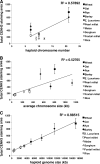Total centromere size and genome size are strongly correlated in ten grass species
- PMID: 22552915
- PMCID: PMC3391362
- DOI: 10.1007/s10577-012-9284-1
Total centromere size and genome size are strongly correlated in ten grass species
Abstract
It has been known for decades that centromere size varies across species, but the factors involved in setting centromere boundaries are unknown. As a means to address this question, we estimated centromere sizes in ten species of the grass family including rice, maize, and wheat, which diverged 60~80 million years ago and vary by 40-fold in genome size. Measurements were made using a broadly reactive antibody to rice centromeric histone H3 (CENH3). In species-wide comparisons, we found a clear linear relationship between total centromere size and genome size. Species with large genomes and few chromosomes tend to have the largest centromeres (e.g., rye) while species with small genomes and many chromosomes have the smallest centromeres (e.g., rice). However, within a species, centromere size is surprisingly uniform. We present evidence from three oat-maize addition lines that support this claim, indicating that each of three maize centromeres propagated in oat are not measurably different from each other. In the context of previously published data, our results suggest that the apparent correlation between chromosome and centromere size is incidental to a larger trend that reflects genome size. Centromere size may be determined by a limiting component mechanism similar to that described for Caenorhabditis elegans centrosomes.
Figures





Similar articles
-
Preferential recruitment of the maternal centromere-specific histone H3 (CENH3) in oat (Avena sativa L.) × pearl millet (Pennisetum glaucum L.) hybrid embryos.Chromosome Res. 2015 Dec;23(4):709-18. doi: 10.1007/s10577-015-9477-5. Epub 2015 Jul 2. Chromosome Res. 2015. PMID: 26134441
-
The compact Brachypodium genome conserves centromeric regions of a common ancestor with wheat and rice.Funct Integr Genomics. 2010 Nov;10(4):477-92. doi: 10.1007/s10142-010-0190-3. Epub 2010 Sep 15. Funct Integr Genomics. 2010. PMID: 20842403
-
Maize centromeres: organization and functional adaptation in the genetic background of oat.Plant Cell. 2004 Mar;16(3):571-81. doi: 10.1105/tpc.018937. Epub 2004 Feb 18. Plant Cell. 2004. PMID: 14973167 Free PMC article.
-
A molecular view of plant centromeres.Trends Plant Sci. 2003 Dec;8(12):570-5. doi: 10.1016/j.tplants.2003.10.011. Trends Plant Sci. 2003. PMID: 14659705 Review.
-
Centromere Size and Its Relationship to Haploid Formation in Plants.Mol Plant. 2018 Mar 5;11(3):398-406. doi: 10.1016/j.molp.2017.12.009. Epub 2017 Dec 19. Mol Plant. 2018. PMID: 29277426 Review.
Cited by
-
Maize centromeric chromatin scales with changes in genome size.Genetics. 2021 Apr 15;217(4):iyab020. doi: 10.1093/genetics/iyab020. Genetics. 2021. PMID: 33857306 Free PMC article.
-
Plasticity of the mitotic spindle in response to karyotype variation.Curr Biol. 2024 Aug 5;34(15):3416-3428.e4. doi: 10.1016/j.cub.2024.06.058. Epub 2024 Jul 22. Curr Biol. 2024. PMID: 39043187 Free PMC article.
-
Exploring the complexity of genome size reduction in angiosperms.Plant Mol Biol. 2024 Nov 1;114(6):121. doi: 10.1007/s11103-024-01518-w. Plant Mol Biol. 2024. PMID: 39485504 Free PMC article. Review.
-
Centromeres drive and take a break.Chromosome Res. 2025 Aug 4;33(1):17. doi: 10.1007/s10577-025-09777-z. Chromosome Res. 2025. PMID: 40759764 Free PMC article. Review.
-
De Novo Centromere Formation and Centromeric Sequence Expansion in Wheat and its Wide Hybrids.PLoS Genet. 2016 Apr 25;12(4):e1005997. doi: 10.1371/journal.pgen.1005997. eCollection 2016 Apr. PLoS Genet. 2016. PMID: 27110907 Free PMC article.
References
-
- Bennetzen JL, Freeling M. The unified grass genome: synergy in synteny. Genome Res. 1997;7:301–306. - PubMed
Publication types
MeSH terms
Substances
LinkOut - more resources
Full Text Sources
Research Materials

